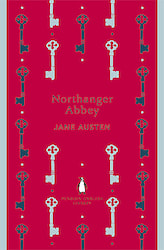
Anyone who has read any Jane Austen has probably read Pride and Prejudice. It is simply wonderful and deserves all the love it gets. But not nearly as many readers have found their way to Northanger Abbey.
Northanger Abbey is the first novel Austen completed (in 1803) after leaving a number of false starts behind. Because of a publishing issue, however, the novel didn’t come out for another 15 years (a year after Austen’s death). Of her six published complete novels, it is decidedly the least mature and least accomplished novel, and in many ways can be seen as a bridge between her juvenalia and her five more accomplished works.
It’s the coming-of-age story of Catherine Morland. Catherine goes “for the season” to Bath with family friends, the Allens. While there, she meets friends of the Allens, the Thorpes, and becomes fast friends with Isabella. Isabella is shallow, conceited, and a terrible person, but Catherine doesn’t see any of her faults. She’s so happy to have an acquaintance, and is so innocent and naive, that she can’t see Isabella for what she is. Isabella becomes engaged to Catherine’s brother James, but abandons him for greener pastures when she learns how poor the Morlands are.
While in Bath, Catherine also meets the Tilneys, and is smitten with the second son, Henry. When the Tilneys invite her to cut her stay in Bath short, and visit them for several weeks at their home, Northanger Abbey, Catherine’s attraction to Henry, her fondness for Henry’s sister Eleanor, and the romance of visiting a ruined abbey all appeal to her sense of adventure and romance, which comes straight from her reading of gothic novels.
The usual mysteries, complications, and reconciliations ensue, and as all of Austen’s novels do, this one ends in a marriage.
Two things about Northanger Abbey set it apart from Austen’s later novels. First, the pairing of Catherine and Henry seems a strange one, not because of their age difference, which is typical of the era, but because Henry is so worldly wise and Catherine is so innocent and naive that she doesn’t really understand Henry. At times his fun is at her expense, and one has to wonder what their future will be like with that intellectual gap. Other marriages in Austen tend to be fairly well suited, even if those pairings won’t be happy ones. Henry and Catherine just don’t seem to fit.
More important a difference, though, is in Austen’s writing style. Northanger Abbey is mostly telling, not showing, and the narrator takes over large swathes of the novel. In her later work, the balance between scene and exposition is much greater.
Nevertheless, Austen’s wit, puncturing satire, and clever dialogue is present even in this early work. It’s a good introduction to her five fully mature novels.
Northanger Abbey is the first novel Austen completed (in 1803) after leaving a number of false starts behind. Because of a publishing issue, however, the novel didn’t come out for another 15 years (a year after Austen’s death). Of her six published complete novels, it is decidedly the least mature and least accomplished novel, and in many ways can be seen as a bridge between her juvenalia and her five more accomplished works.
It’s the coming-of-age story of Catherine Morland. Catherine goes “for the season” to Bath with family friends, the Allens. While there, she meets friends of the Allens, the Thorpes, and becomes fast friends with Isabella. Isabella is shallow, conceited, and a terrible person, but Catherine doesn’t see any of her faults. She’s so happy to have an acquaintance, and is so innocent and naive, that she can’t see Isabella for what she is. Isabella becomes engaged to Catherine’s brother James, but abandons him for greener pastures when she learns how poor the Morlands are.
While in Bath, Catherine also meets the Tilneys, and is smitten with the second son, Henry. When the Tilneys invite her to cut her stay in Bath short, and visit them for several weeks at their home, Northanger Abbey, Catherine’s attraction to Henry, her fondness for Henry’s sister Eleanor, and the romance of visiting a ruined abbey all appeal to her sense of adventure and romance, which comes straight from her reading of gothic novels.
The usual mysteries, complications, and reconciliations ensue, and as all of Austen’s novels do, this one ends in a marriage.
Two things about Northanger Abbey set it apart from Austen’s later novels. First, the pairing of Catherine and Henry seems a strange one, not because of their age difference, which is typical of the era, but because Henry is so worldly wise and Catherine is so innocent and naive that she doesn’t really understand Henry. At times his fun is at her expense, and one has to wonder what their future will be like with that intellectual gap. Other marriages in Austen tend to be fairly well suited, even if those pairings won’t be happy ones. Henry and Catherine just don’t seem to fit.
More important a difference, though, is in Austen’s writing style. Northanger Abbey is mostly telling, not showing, and the narrator takes over large swathes of the novel. In her later work, the balance between scene and exposition is much greater.
Nevertheless, Austen’s wit, puncturing satire, and clever dialogue is present even in this early work. It’s a good introduction to her five fully mature novels.
 RSS Feed
RSS Feed
